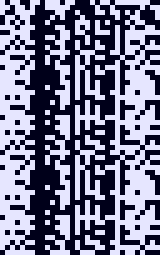
Random Boolean Networks
You can find here my papers, software, and data related to Random Boolean Networks. You can also check other people's work on RBNs.
If RBNs are novel for you, this tutorial is a good place to start with.


Try RBNLab 5.0 (redrbn 1.0), or download
it to run faster (Java source code included). This is a software laboratory for exploring the properties of different types of RBNs. You can use it via your web browser. See README. If you want to contribute to RBNLab, visit http://rbn.sourceforge.net (@  )
)
If you use Matlab, you should try the RBN Toolbox  developed by Christian Schwarzer and Christof Teuscher at EPFL. Also, you can try BN/PBN Toolbox for Matlab, for RBNs and probabilistic Boolean networks, maintained by Harri Lähdesmäki and Ilya Shmulevich
developed by Christian Schwarzer and Christof Teuscher at EPFL. Also, you can try BN/PBN Toolbox for Matlab, for RBNs and probabilistic Boolean networks, maintained by Harri Lähdesmäki and Ilya Shmulevich
If you are interested in "classic" RBNs and cellular automata (synchronous updating), you should really check Andy Wuensche's DDLab 
Classification of Random Boolean Networks
This work was published in:
Gershenson, C. (2002).
Classification of Random Boolean Networks
In Standish, R. K., M. A. Bedau, and H. A. Abbass (eds.)
Artificial Life VIII: Proceedings of the Eight International Conference on Artificial Life.
. pp. 1-8.
Sydney, Australia. MIT Press[pdf], [html].
Abstract:
We provide the first classification of different types of
Random Boolean Networks (RBNs). We study the differences
of RBNs depending on the degree of synchronicity and
determinism of their updating scheme. For doing so, we first
define three new types of RBNs. We note some similarities
and differences between different types of RBNs with the aid
of a public software laboratory we developed. Particularly, we
find that the point attractors are independent of the updating
scheme, and that RBNs are more different depending on their
determinism or non-determinism rather than depending on
their synchronicity or asynchronicity. We also show a way of
mapping non-synchronous deterministic RBNs into
synchronous RBNs. Our results are important for justifying
the use of specific types of RBNs for modelling natural
phenomena.
Contextual Random Boolean Networks
Gershenson, C., J. Broekaert, and D. Aerts (2003).
Contextual Random Boolean Networks
In Banzhaf, W, T. Christaller, P. Dittrich, J. T. Kim, and J. Ziegler, Advances in Artificial Life, 7th European Conference, ECAL 2003, Dortmund, Germany, pp. 615-624. LNAI 2801. Springer.
Abstract:
We propose the use of Deterministic Generalized Asynchronous
Random Boolean Networks (Gershenson, 2002) as models of contextual
deterministic discrete dynamical systems. We show that changes in the context
have drastic effects on the global properties of the same networks, namely the
average number of attractors and the average percentage of states in attractors.
We introduce the situation where we lack knowledge on the context as a more
realistic model for contextual dynamical systems. We notice that this makes the
network non-deterministic in a specific way, namely introducing a
non-Kolmogorovian quantum-like structure for the modelling of the network
(Aerts 1986). In this case, for example, a state of the network has the
potentiality (probability) of collapsing into different attractors, depending on
the specific form of lack of knowledge on the context.
The precise data and clearer graphs of this work can be found here.
Phase Transitions in Random Boolean Networks
Gershenson, C. (2003).
Phase Transitions in Random Boolean Networks with Different Updating Schemes
Submitted to Physica D.
Abstract:
In this paper we study the phase transitions of different types of Random
Boolean networks. These differ in their updating scheme: synchronous,
semi-synchronous, or asynchronous, and deterministic or non-deterministic. It
has been shown that the statistical properties of Random Boolean networks
change considerable according to the updating scheme. We study with computer
simulations sensitivity to initial conditions as a measure of order/chaos. We
find that independently of their updating scheme, all network types have very
similar phase transitions, namely when the average number of connections of
nodes is between one and three. This critical value depends more on the size of
the network than on the updating scheme.
The precise data and clearer graphs of this work can be found here.
Updating Schemes in Random Boolean Networks: Do They Really Matter?
Gershenson, C. (2004).
Updating Schemes in Random Boolean Networks: Do They Really Matter?
In Pollack, J., M. Bedau, P. Husbands, T. Ikegami, and R. A. Watson (eds.) Artificial Life IX, Proceedings of the Ninth International Conference on the Simulation and Synthesis of Living Systems. pp. 238-243. MIT Press.
Abstract:
In this paper we try to bring the debate concerning different updating schemes in RBNs to an end. We quantify for the first time loose attractors in asyncrhonous random Boolean networks (RBNs), which allows us to analyze the complexity reduction related to different updating schemes. We also report that all updating schemes yield very similar critical stability values, meaning that the "edge of chaos" does not depend on the updating scheme. After discussion, we conclude that synchonous RBNs are justifiable theoretical models of biological networks.
The precise data and clearer graphs of this work can be found here.
Introduction to Random Boolean Networks
Gershenson, C. (2004).
Introduction to Random Boolean Networks
In Bedau, M., P. Husbands, T. Hutton, S. Kumar, and H. Suzuki (eds.) Workshop and Tutorial Proceedings, Ninth International Conference on the Simulation and Synthesis of Living Systems (ALife IX). pp. 160-173.
Abstract:
The goal of this tutorial is to promote interest in the study of random Boolean networks (RBNs). These can be very interesting models, since one does not have to assume any functionality or particular connectivity of the networks to study their generic properties. Like this, RBNs have been used for exploring the configurations where life could emerge. The fact that RBNs are a generalization of cellular automata makes their research a very important topic. The tutorial, intended for a broad audience, presents the state of the art in RBNs, spanning over several lines of research carried out by different groups. We focus on research done within artificial life, as we cannot exhaust the abundant research done over the decades related to RBNs.
The Role of Redundancy in the Robustness of Random Boolean Networks
Gershenson, C., S. A. Kauffman, and I. Shmulevich (2006). The Role of Redundancy in the Robustness of Random Boolean Networks. In Rocha, L. M., L. S. Yaeger, M. A. Bedau, D. Floreano, R. L. Goldstone, and A. Vespignani (Eds.), Artificial Life X, Proceedings of the Tenth International Conference on the Simulation and Synthesis of Living Systems. pp. 35-42. MIT Press.
Abstract:
Evolution depends on the possibility of successfully exploring fitness landscapes via mutation and recombination. With these search procedures, exploration is difficult in "rugged" fitness landscapes, where small mutations can drastically change functionalities in an organism. Random Boolean networks (RBNs), being general models, can be used to explore theories of how evolution can take place in rugged landscapes; or even change the landscapes.
In this paper, we study the effect that redundant nodes have on the robustness of RBNs. Using computer simulations, we have found that the addition of redundant nodes to RBNs increases their robustness. We conjecture that redundancy is a way of "smoothening" fitness landscapes. Therefore, redundancy can facilitate evolutionary searches. However, too much redundancy could reduce the rate of adaptation of an evolutionary process. Our results also provide supporting evidence in favour of Kauffman's conjecture (Kauffman, 2000, p.195).



)
![]() developed by Christian Schwarzer and Christof Teuscher at EPFL. Also, you can try BN/PBN Toolbox for Matlab, for RBNs and probabilistic Boolean networks, maintained by Harri Lähdesmäki and Ilya Shmulevich
developed by Christian Schwarzer and Christof Teuscher at EPFL. Also, you can try BN/PBN Toolbox for Matlab, for RBNs and probabilistic Boolean networks, maintained by Harri Lähdesmäki and Ilya Shmulevich
![]()